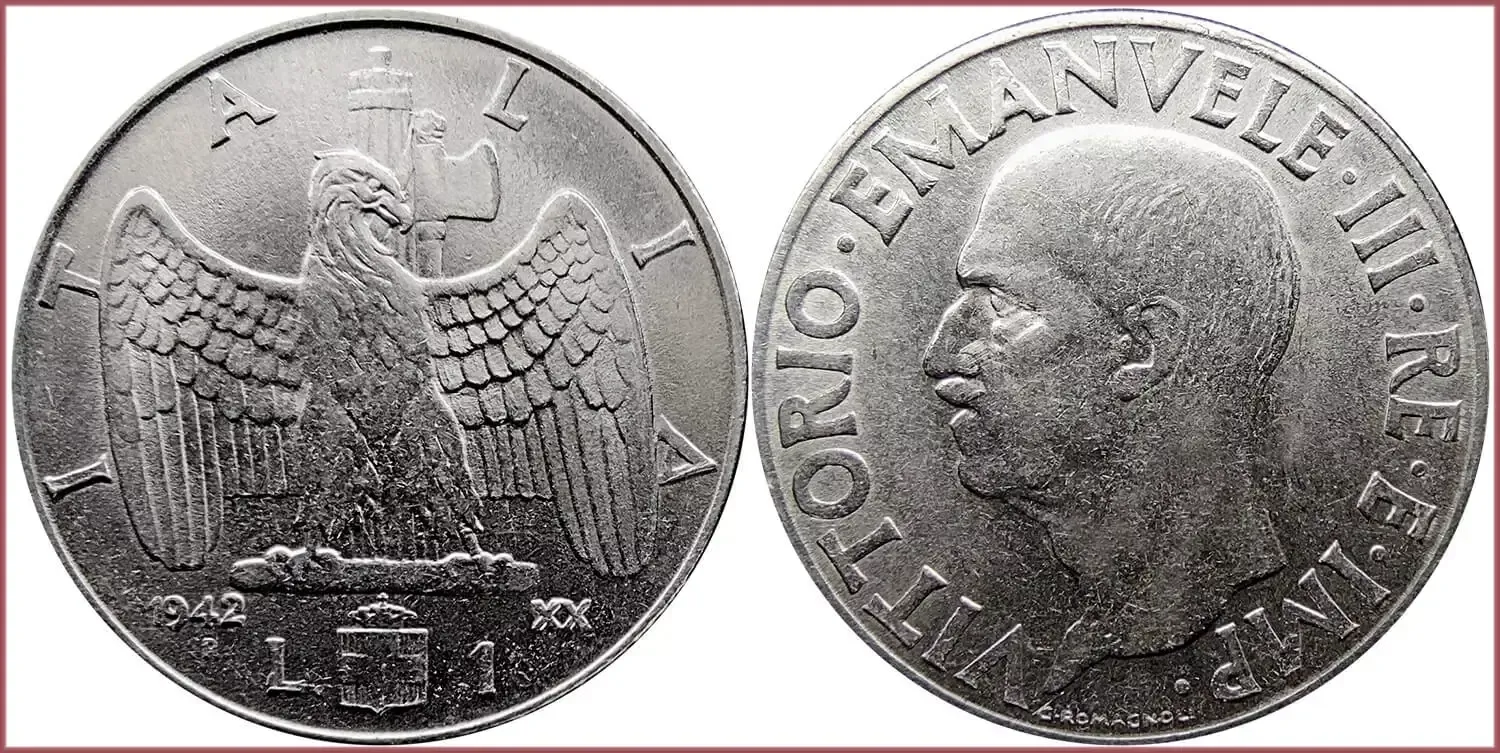LIRA: COIN OF ITALY
1 lira, 1942: Kingdom of Italy
Ruler (actual): Benito Mussolini — Italian dictator who founded and led the National Fascist Party. He was Prime Minister of Italy from 1922 until 1943, as well as "Duce" of Italian fascism until his execution in 1945.
ITALIA: Italy.
1942 - XX: the 20th year of the reign of Benito Mussolini.
The aggressive eagle, crowned Savoy shield (the central element of the coat of arms of Italy at that time) and fascia as a symbol of the fascist regime in Italy.
R (micro-writing): symbol of Rome Mint.
L. 1: 1 lira.
VITTORIO EMANVELE III RE E IMP (Vittorio Emanuele III Re e Imperatore): Victor Emmanuel III King and Emperor.
Portrait of the King.
Victor Emmanuel III — the 3rd King of a united Italy of modern times (1900-1946), Emperor of Ethiopia, King of Albania. Representative of the Savoy dynasty. The period of his reign was the dawn of fascism in Italy, under which Benito Mussolini actually ruled, and the king turned into a puppet figure under him. However, at the end of his reign, Victor Emmanuel supported the overthrow of Mussolini, and after the end of World War II, he abdicated.
Coin design: Giuseppe Romagnoli (sign below the portrait "G. ROMAGNOLI").
Rome Mint (Italy).
Mintage: 5.700.000.
- Acmonital: 26 mm - 7.9 g
- Reference price: 1.3$
COIN LIRA — WHERE & WHEN (coins catalog: by names & emitents)
- ITALY (1861-2001): lira = 100 centesimo
- ITALIAN STATES (15th-19th centuries): lira = 20 soldo
- VATICAN CITY (1929-2001): lira = 100 centesimo
- SAN MARINO (1898-2001): lira = 100 centesimo
- ITALIAN ERITREA (1890-1896): lira = 100 centesimo = 1/5 tallero
- ITALIAN SOMALILAND (1925): lira = 100 centesimo
- REPUBLIC OF MALTA (1977-2007): lira = 1000 mil = 100 cent
- STATE OF ISRAEL (1958-1980): lira or pound = 100 agora (before 1960: 1000 pruta)
- REPUBLIC OF TURKEY (1937-2004): lira = 100 kuruş (since 2009: lirasi)
LIRA as coin name.
My interest in numismatics arose in the days when a coin with the denomination lira was in the collection of almost every beginner. The name of the currency was constantly heard: be it Italian or Turkish lira. It was the beginning of the 90s...
And after 10-15 years, the lira receded into the background: Italy switched to the euro (as well as several other smaller issuers of the lira in Europe), and since 2005, Turkey replaced the writing of the name of the denomination with the local variant — lirasi (from a formal point of view, I think this coin name is independent).
Be that as it may, I consider the lira one of the iconic coins in world numismatics: it is known about hundreds of types of this coin that were produced over a long period of time — at least from the 15th to the beginning of the 21st century.
The appearance of the first lira is attributed to the times of Medieval Italy: first as a measure of money (a measure of the weight of the metal of coins), a little later — as a silver coin. Various Italian states minted lira: the Republic of Venice, the Lombardo-Venetian Kingdom, the Duchy of Lucca, the Grand Duchy of Tuscany, the Kingdom of Sardinia, the Duchy of Parma, the Papal States... After the unification of Italy in 1861, the lira became the main monetary unit of the newly formed state. In addition, the Italians at one time introduced local lira in the territories of colonial African possessions: Italian Somaliland (since 1925) and Eritrea (since 1890).
In 1864, the lira was introduced in the territory of San Marino, in 1929 — in the Vatican, and in 1983 — in Malta. The San Marino and Vatican lira were equated to the Italian lira and were used as a means of payment in all three states.
During 1952-1980, the lira was the currency of Israel; it was introduced instead of the Palestinian pound and replaced by the local sheqel. In some literature, instead the phrase "Israeli pound" is often found — in Hebrew, as well as in Turkish, Greek and Arabic, the word "lira" means "pound".
Turkey became the last country in the world to abandon the minting of lira coins. In fact, the lira continues to be the currency of Turkey, but the latest issues contain the name of the denomination in the format "lirasi".
The name of the lira coin comes from the name of the Roman measure of weight of silver — pound (in Latin "pondus libra" — "pound of weight").











